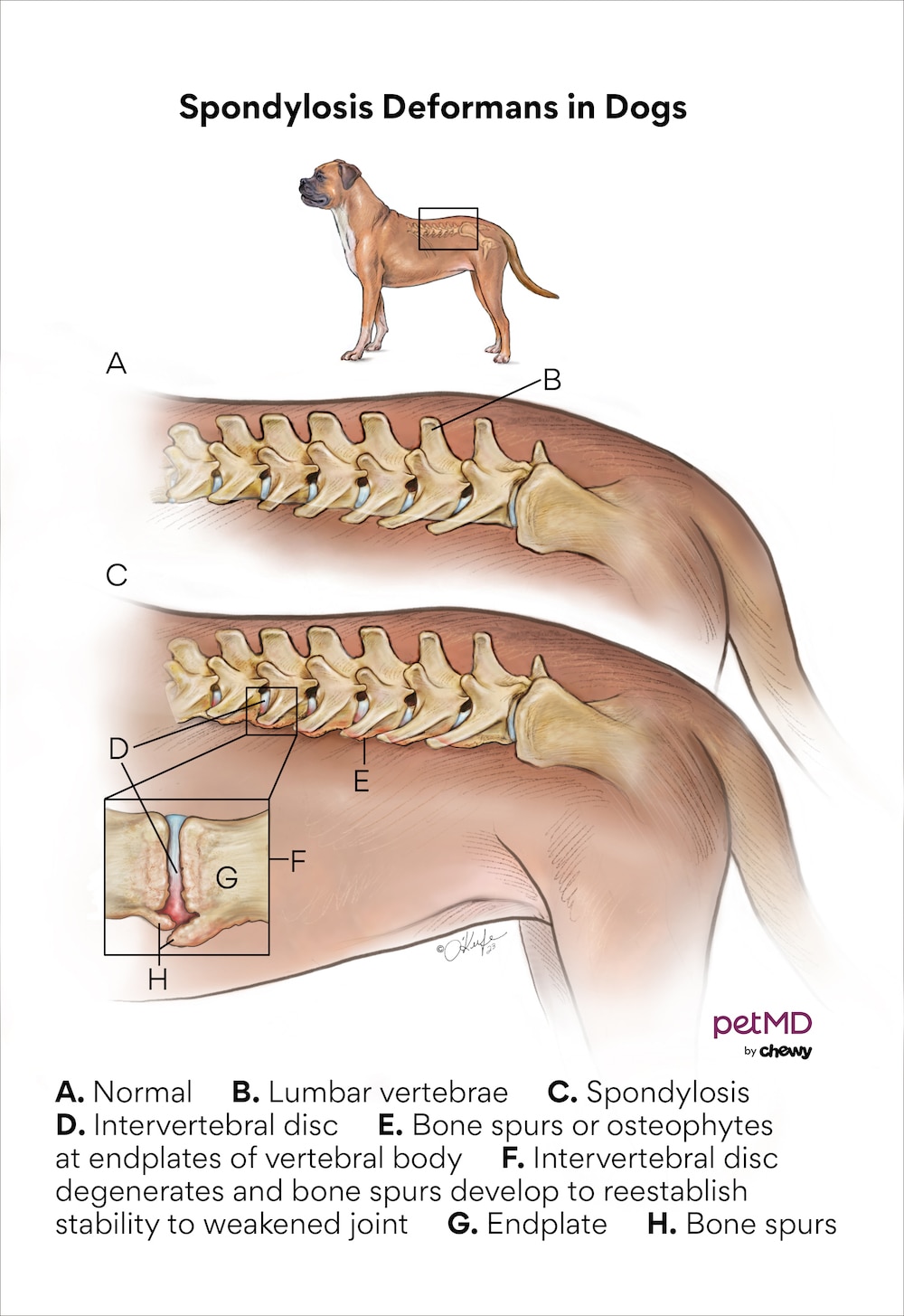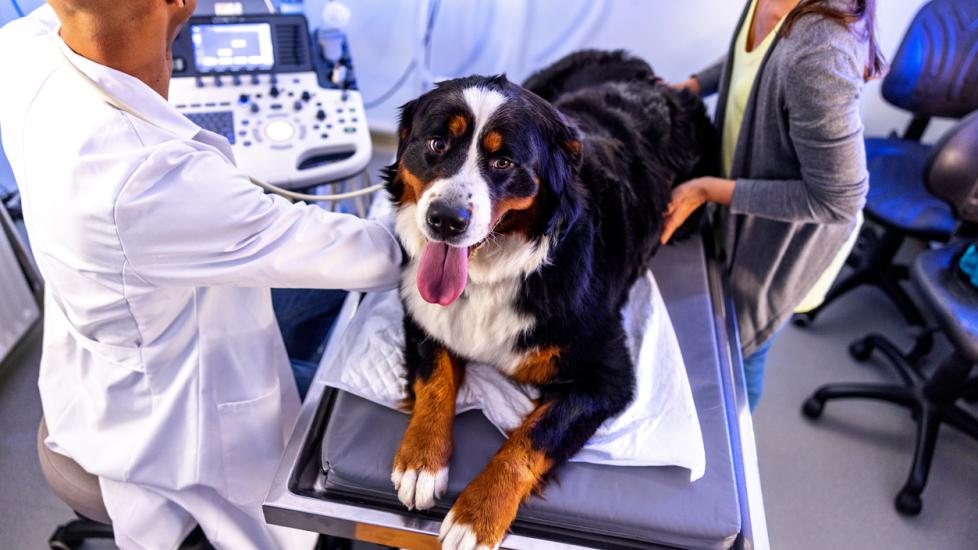Spondylosis Deformans in Dogs
What Is Spondylosis Deformans in Dogs?
Spondylosis deformans is a common degenerative disorder of the spinal column. It affects the vertebral bones of the spine and is characterized by the presence of bony spurs or osteophytes that form along the underside and on the edges of the spinal vertebrae. A bony growth can develop in a single spot on the spine or in multiple locations.
In dogs, the most common area affected is the lumbar vertebrae, or lower back around the hips. Sometimes, the bony growths can be large enough that they appear to form a complete bridge from one vertebral bone to the next, fusing or linking the vertebrae together. This condition causes a noninflammatory, irreversible damage to the spinal vertebrae, which can result in loss of function and mobility issues.
Spondylosis is most prevalent in large-breed dogs that are middle aged or older, but it can also occur in all breeds and sizes. Boxers are the most common breed affected. In most dogs, this degenerative condition will begin to develop by age 10. It is estimated that up to 70% of 9-year-old dogs are affected.

Symptoms of Spondylosis Deformans in Dogs
Most of the time, spondylosis does not produce any clinical signs. Some dogs may show signs of back pain in rare cases, as the bone spurs restrict movement of the spine and can put pressure on the nerves that come out of the spinal canal. Other symptoms may include:
-
Vocalizing when specific areas of the back are touched or manipulated
-
Hunched back stance, abnormal posture
-
Reluctance to walk
-
Lameness, limping
-
Trouble laying down and getting up comfortably
-
Stiffness
-
Decreased appetite
-
Lethargy, not acting like themselves
-
Restricted motion, changes in flexibility
If your dog is exhibiting any of these clinical signs, have your pet examined by a veterinarian as soon as possible.
Causes of Spondylosis Deformans in Dogs
Spondylosis deformans is a degenerative condition of the vertebral bones, and it commonly develops in dogs as part of the natural aging process. It can also be caused by trauma (both small and major injury) or in those that have a genetic predisposition to bone spurs. Microtrauma over time can be caused by repetitive damage to the same joints and bones with repeated exercise or other activities, whereas major trauma can occur with a serious injury.
Spondylosis develops secondary to a degenerative process of the soft disc material in between the vertebrae. The intervertebral discs act as shock absorbers to cushion, but when they become damaged it makes the joints in between the vertebral bones unstable, thus producing abnormal motion. In reaction to the abnormal joint movement, the bone spurs of spondylosis deformans develop to reestablish the stability of the weakened joint or joints. The bone spurs grow only as large as needed to reinforce the diseased joint.
How Veterinarians Diagnose Spondylosis Deformans in Dogs
Spondylosis deformans is a condition of the spine that is commonly diagnosed when older animals are being examined for unrelated conditions. Your veterinarian will first take a complete history of your dog’s health and do a physical examination, including a neurologic and orthopedic exam to evaluate why your dog is exhibiting signs of back pain.
Your vet may recommend blood work such as a biochemistry profile, complete blood count, electrolyte panel, and urinalysis to assess your dog’s overall health. Spondylosis deformans is diagnosed with imaging techniques, most commonly with x-rays of the spine, chest, and abdomen. The x-rays may reveal new bone growths, or osteophytes, along the vertebrae. In advanced cases, these osteophytes form a bridge from one vertebrae to the next.
Other diagnostics, such as a myelogram (a special dye injected into the spinal fluid around the spinal cord, followed by x-rays) or magnetic resonance imaging (MRI), are used to help evaluate your dog for other causes of back pain that might cause the secondary spondylosis to form. Both MRI and CT scans can show where a bone spur might be pressing on your dog’s spinal cord or nerves causing neurologic symptoms. Your primary veterinarian might need to refer you to a specialty hospital where a surgeon or neurologist can perform advanced diagnostics and treatments.
Treatment of Spondylosis Deformans in Dogs
The treatment for spondylosis deformans is directly related to the symptoms that your dog is displaying. If they are not displaying any clinical signs, no treatment is necessary. If your dog has pain or stiffness, conservative treatment is usually sufficient. This could include pain medication, controlled exercise or strict rest, and a weight loss regimen if your dog is overweight to reduce the amount of stress on the spine.
Oral medications may consist of non-steroidal anti-inflammatories (NSAIDs) or other pain relievers such as tramadol or gabapentin. Physical therapy and acupuncture can also be helpful to regain strength and help with mobility. In rare cases, if the bone spurs are causing severe pain or significant neurologic issues, your veterinarian might recommend hospitalization and surgery.
Recovery and Management of Spondylosis Deformans in Dogs
Although the prognosis is generally good, your veterinarian will discuss the prognosis for your dog based on diagnostic testing and/or their response to treatment. It’s important that you follow up with your veterinarian for check-ups to ensure that your dog’s pain is managed appropriately. This is a progressive condition, meaning that it can get worse as your dog ages but symptoms can be managed.
If your dog does not show any symptoms, spondylosis deformans may go undetected for years or even for their lifetime. Most affected dogs live a long, full life with this condition, with the pain and lack of flexibility managed with long-term treatment if needed. Maintaining a weight loss plan and keeping your dog lean is extremely important. Since this condition affects older dogs who may be suffering from other causes of pain such as arthritis, you can support your dog by using soft bedding and a safe, quiet place for them to rest.
Talking to your veterinarian about your dog’s diet is recommended to ensure they have an optimal balance of essential fatty acids, which have been proven to reduce inflammation and reduce the need for pain relief in pets. Ensure that your dog maintains a healthy weight, as being overweight can cause undue stress on the body, increasing pain. If your dog is overweight, discuss a nutrition plan with your veterinarian. Nutritional supplements such as glucosamine, methylsulphonylmethane (MSM), and chondroitin sulfate are great to help promote long-term joint health, even for joints in the spine.
Featured Image: iStock.com/AzmanJaka
